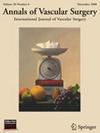腹股沟下外周动脉病变行动脉粥样硬化切除术患者狭窄和闭塞定位的远期疗效比较
IF 1.6
4区 医学
Q3 PERIPHERAL VASCULAR DISEASE
引用次数: 0
摘要
目的:血管内治疗是外周动脉疾病的有效治疗选择,外周动脉疾病是一种发病率不断上升的常见病。血管制备方法在血管内治疗中的重要性是众所周知的,动脉粥样硬化切除术是其中一种方法,经常用于治疗外周动脉疾病患者。在这项研究中,我们的目的是根据病变位置比较腹股沟下外周动脉疾病行动脉粥样硬化切除术的患者的初级通畅率和长期预后。方法:回顾性分析2014年1月至2018年12月,三级学术中心心血管外科因腹股沟下外周动脉疾病行动脉粥样硬化切除术的120例患者。统计数据、跛行距离、卢瑟福分类、踝/肱指数(ABI)、病变长度和定位。根据病变部位将患者分为三组:SFA组、腘窝组和腘下组。所有患者均行旋转动脉粥样硬化切除术和随后的球囊血管成形术。术后随访1年、2年和5年,分别记录踝/肱指数、卢瑟福分级和多普勒超声结果。结果:本研究共纳入120例患者。患者平均年龄68.75±7.44岁。120例患者中有115例(95.83%)获得急性技术成功。结论:在腹股沟下外周动脉病变的血管内治疗中,应考虑血管准备方法。我们可以得出结论,动脉粥样硬化切除术和随后的补充药物包被球囊血管成形术的技术成功率很高,外周动脉疾病引起的再狭窄率和并发症率处于可接受的水平,保持生活方式的改变和术后定期应用药物治疗。本文章由计算机程序翻译,如有差异,请以英文原文为准。
Comparison of Long-Term Results According to Localization of Stenosis and Occlusion in Patients Undergoing Atherectomy for Infrainguinal Peripheral Arterial Disease
Background
Endovascular treatment is an effective treatment option for peripheral arterial disease, which is a common disease with an increasing incidence rate. The importance of vessel preparation methods in endovascular treatment is well understood, and atherectomy, one of these methods, is frequently used to treat patients with peripheral arterial disease. In this study, we aimed to compare the primary patency rates and long-term outcomes of patients who underwent atherectomy for infrainguinal peripheral arterial disease according to lesion location.
Methods
In the Department of Cardiovascular Surgery at Tertiary Academic Center, 120 patients who underwent atherectomy due to infrainguinal peripheral arterial disease between January 2014 and December 2018 were retrospectively examined. Demographic data, claudication distance, Rutherford classification, ankle/brachial index (ABI), lesion length and localization were noted. The patients were divided into three groups on the basis of lesion location: superficial femoral artery (SFA), popliteal, or infrapopliteal. All patients underwent rotational atherectomy and subsequent balloon angioplasty. The ABI, Rutherford classification, and Doppler ultrasonography results were recorded at the 1-, 2- and 5-year follow-ups after the procedure.
Results
There were a total of 120 patients in the study. The mean age of the patients was 68.75 ± 7.44 years. Acute technical success was achieved in 115 (95.83%) of the 120 patients. The rates of patients with <50% noncritical stenosis based on Doppler ultrasonography control were 100.0% in the SFA group, 100.0% in the popliteal group, and 88.9% in the infrapopliteal group at the first year; 95.0%, 93.0%, and 80.6% at the second year; and 89.2%, 84.0%, and 75.0% at the fifth year, respectively. The rate of <50% noncritical stenosis in all patients was 96.5% at the first year, 89.6% at the second year, and 82.8% at the fifth year.
Conclusion
Vessel preparation methods should be considered in the endovascular treatment of infrainguinal peripheral arterial disease. We can conclude that the technical success rates of atherectomy and subsequent complementary drug-coated balloon angioplasty are high, and the restenosis rates and complication rates due to peripheral arterial disease are at an acceptable level with the preservation of lifestyle changes and the regular application of medical treatment after the procedure.
求助全文
通过发布文献求助,成功后即可免费获取论文全文。
去求助
来源期刊
CiteScore
3.00
自引率
13.30%
发文量
603
审稿时长
50 days
期刊介绍:
Annals of Vascular Surgery, published eight times a year, invites original manuscripts reporting clinical and experimental work in vascular surgery for peer review. Articles may be submitted for the following sections of the journal:
Clinical Research (reports of clinical series, new drug or medical device trials)
Basic Science Research (new investigations, experimental work)
Case Reports (reports on a limited series of patients)
General Reviews (scholarly review of the existing literature on a relevant topic)
Developments in Endovascular and Endoscopic Surgery
Selected Techniques (technical maneuvers)
Historical Notes (interesting vignettes from the early days of vascular surgery)
Editorials/Correspondence

 求助内容:
求助内容: 应助结果提醒方式:
应助结果提醒方式:


